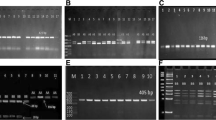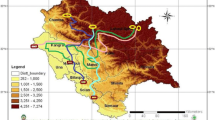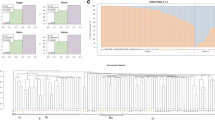Abstract
Ten single nucleotide polymorphisms were used for genotyping of 176 Tongshan Black-boned goats, which are Chinese indigenous goat colony for meat production. The average individual heterozygosity was 0.292. To assess the correlations between individual heterozygosity and growth in Tongshan Black-boned goat individuals, and the potential of using individual heterozygosity as an indicator of growth, the data of growth traits, including body weight, height at withers, body length, chest girth and cannon circumference, were collected. Significant correlations were observed between individual heterozygosity and body weight, height at withers, body length, heart girth, cannon circumference (P < 0.05). All the significant regression showed positive slope with R square values ranged from 0.0251 to 0.0368. These data suggests that individual heterozygosity is positively correlated with growth traits in Tongshan Black-boned goat individuals and associative overdominance may affect Tongshan Black-boned goat growth significantly. Therefore it is possible to use individual heterozygosity as an indicator of growth. Our results also provide a strong support to the overdominance hypothesis.


Similar content being viewed by others
References
Frydenberg O (1963) Population studies of a lethal mutant in Drosophila melanogaster. I. Behavior in populations with discrete generations. Hereditas 50:89–116
Ohta T (1971) Associative overdominance caused by linked detrimental mutations. Genet Res 18:277–286
Ohta T (1973) Slightly deleterious mutant substitutions in evolution. Nature 246:96–98
Mitton JB, Grant MC (1984) Associations among protein heterozygosity, growth rate, and developmental homeostasis. Annu Rev Ecol Syst 15:479–499
Forstmeier W, Schielzeth H, Mueller JC, Ellegren H, Kempenaers B (2012) Heterozygosity-fitness correlations in zebra finches: microsatellite markers can be better than their reputation. Mol Ecol 21:3237–3249
Voegeli B, Saladin V, Wegmann M, Richner H (2012) Parasites as mediators of heterozygosity-fitness correlations in the Great Tit (Parus major). J Evol Biol 25:584–590
Luquet E, David P, Lena JP, Joly P, Konecny L, Dufresnes C, Perrin N, Plenet S (2012) Heterozygosity-fitness correlations among wild populations of European tree frog (Hyla arborea) detect fixation load. Mol Ecol 20:1877–1887
Govindaraju DR, Larson MG, Yin X, Benjamin EJ, Rao MB, Vasan RS (2009) Association between SNP heterozygosity and quantitative traits in the Framingham heart study. Ann Hum Genet 73:465–473
Vilhunen S, Tiira K, Laurila A, Hirvonen H (2008) The bold and the variable: fish with high heterozygosity act recklessly in the vicinity of predators. Ethology 114:7–15
Liu GQ, Jiang XP, Wang JY, Wang ZY (2006) Correlations between heterozygosity at microsatellite loci, mean d 2 and body weight in a Chinese native chicken. Asian Aust J Anim 19:1671–1677
Lieutenant-Gosselin M, Bernatchez L (2006) Local heterozygosity-fitness correlations with global positive effects on fitness in threespine stickleback. Evolution 60:1658–1668
Koehn RK, Gaffney PM (1984) Genetic heterozygosity and growth rate in Mytilus edulis. Mar Biol 82:1–7
Diehl WJ, Biesiot PM (1994) Relationships between multilocus heterozygosity and morphometric indices in a population of the deep-sea red crab Chaceon quinquedens (Smith). J Exp Mar Biol Ecol 182:237–250
Wu XL, Li X, Merete F (2001) Association of microsatellite genomic heterozygosity with inbred pig performance under successive inbreeding. Yi Chuan Xue Bao 28:20–28 (in Chinese)
Jiang XP, Liu GQ, Xiong YZ (2005) Investigation of gene and microsatellite heterozygosities correlated to growth rate in the Chinese Meishan pig. Asian Aust J Anim 18:927–932
Di Fonzo MMI, Pelletier F, Clutton-Brock TH, Pemberton JM, Coulson T (2011) The population growth consequences of variation in individual heterozygosity. PLoS One 6:e19667
Fassatoui C, Chenuil A, Romdhane MS (2012) Relationships between heterozygosity, growth parameters and age in the common pandora Pagellus erythrinus (Sparidae) in the Gabes Gulf (Tunisia). Mar Ecol Prog Ser 445:251–261
Borrell YJ, Carleos CE, Sánchez JA, Vázquez E, Gallego V, Asturiano JF, Blanco G (2011) Heterozygosity-fitness correlations in the Gilthead Sea bream Sparus aurata using microsatellite loci from unknown and gene-rich genomic locations. J Fish Biol 79:1111–1129
Küpper C, Kosztolányi A, Augustin J, Dawson DA, Burke T, Székely T (2010) Heterozygosity-fitness correlations of conserved microsatellite markers in Kentish plovers Charadrius alexandrines. Mol Ecol 19:5172–5185
Pujolar JM, Maes GE, Vancoillie C, Volckaert FA (2006) Environmental stress and life-stage dependence on the detection of heterozygosity-fitness correlations in the European eel, Anguilla Anguilla. Genome 49:1428–1437
Appleyard SA, Renwick JM, Mather PB (2001) Individual heterozygosity levels and relative growth performance in Oreochromis niloticus (L.) cultured under Fijian conditions. Aquac Res 32:287–296
FAO (2007) The State of the World’s Animal Genetic Resources for Food and Agriculture. FAO, Rome
Di R, Chu MX, Li YL, Zhang L, Fang L, Feng T, Cao GL, Chen HQ, Li XW (2012) Predictive potential of microsatellite markers on heterosis of fecundity in crossbred sheep. Mol Biol Rep 39:2761–2766
An X, Wang L, Hou J, Li G, Song Y, Wang J, Yang M, Cui Y, Cao B (2011) Novel polymorphisms of goat growth hormone and growth hormone receptor genes and their effects on growth traits. Mol Biol Rep 38:4037–4043
Fang X, Zhang J, Xu H, Zhang C, Du Y, Shi X, Chen D, Sun J, Jin Q, Lan X, Chen H (2012) Polymorphisms of diacylglycerol acyltransferase 2 gene and their relationship with growth traits in goats. Mol Biol Rep 39:1801–1807
Zhang C, Liu Y, Xu D, Wen Q, Li X, Zhang W, Yang L (2012) Polymorphisms of myostatin gene (MSTN) in four goat breeds and their effects on Boer goat growth performance. Mol Biol Rep 39:3081–3087
Han D, Li G, Cao BY, Wang YN, Li L, Zhu GQ, Wang JG, Song YX (2009) Polymorphism of GnRHR gene and its relationship with litter size trait of Saanen Dairy Goat. J China Agric Univ 14:93–97 (in Chinese)
Du L, Xu GY, Wei HW, Wang DH, Li Y, Cheng TT, Ni M (2010) Study on SNPs of the FSHβ Gene and its Association with Litter Sizes of Tianfu Goat. China Anim Husb Vet Med 37:150–153 (in Chinese)
Yan LJ, Liu B, Fang XT, Chen H, Zhang RF, Bao B, Zhang HJ (2006) Analysis of gene polymorphisms in qinchuan cattle and Chinese Holstein cattle. Yi Chuan 28:1371–1375 (in Chinese)
Sun RP, Wang LX, Wang JG, Zhu GQ, Song YX, Cao BY (2009) Polymorphism of LHβ gene and its relationship with litter number of goat. J Northwest A&F Univ (Nat Sci Ed) 37:52–57 (in Chinese)
Pujolar JM, Maes GE, Vancoillie C, Volckaert FA (2005) Growth rate correlates to individual heterozygosity in the European eel, Anguilla anguilla L. Evolution 59:189–199
Hoffman JI, Hanson N, Forcada J, Trathan PN, Amos W (2010) Getting long in the tooth: a strong positive correlation between canine size and heterozygosity in Antarctic fur seals Arctocephalus gazella. J Hered 101:527–538
Ferguson A (1994) Molecular genetics in fisheries: current and future perspectives. Rev Fish Biol Fish 4:379–383
Pamilo P, Pálsson S (1998) Associative overdominance, heterozygosity and fitness. Heredity (Edinb) 81:381–389
Bierne N, Tsitrone A, David P (2000) An inbreeding model of associative overdominance during a population bottleneck. Genetics 155:1981–1990
Acknowledgments
The project was financially supported by the China National Meat-type Sheep and Goat Industrial Technology System (CARS-39-1A). We express our gratitude to the Tongshan Black-boned Goat Breeding Co., Ltd for providing samples plus data.
Author information
Authors and Affiliations
Corresponding author
Rights and permissions
About this article
Cite this article
Han, Y.G., Liu, G.Q., Jiang, X.P. et al. Investigation of individual heterozygosity correlated to growth traits in Tongshan Black-boned goat. Mol Biol Rep 40, 6075–6079 (2013). https://doi.org/10.1007/s11033-013-2717-x
Received:
Accepted:
Published:
Issue Date:
DOI: https://doi.org/10.1007/s11033-013-2717-x




